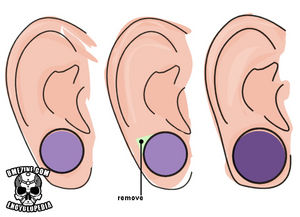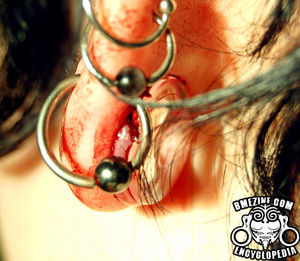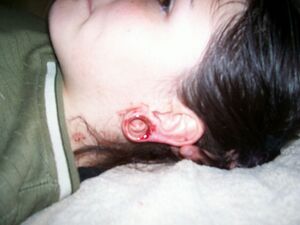Scalpelled Labret and Scalpelled Lobe: Difference between pages
(Page conversion via llm-mediawiki-rev -jwm) |
(Page conversion via llm-mediawiki-rev -jwm) |
||
| Line 1: | Line 1: | ||
[[File: | [[File:Earscalpdiagram.jpg|thumb|right|300px]] | ||
[[File:Backcutcopy.jpg|thumb|right|300px]] | |||
[[File:Scalpeled.jpg|thumb|right|[180px|IAM:doom_kitty's newly scalpeled lobe]] | |||
''' | '''Ear piercings increased in size via cutting''' | ||
It is possible to turn two earlobe piercings into one larger hole by cutting between them, either in a straight line, or by removing a portion of tissue. | |||
Alternatively, making a small [[Scalpel|scalpel]] cut outward from an existing earlobe piercing is one method used to enlarge a piercing very quickly, without the time needed for stretching. This is illustrated in the diagram. The advantage to this method over regular [[Stretching|stretching]] is that it gives precise control over which tissue is thinned out. In addition, it may also allow for a slight relocation of a piercing. | |||
Earlobe scalpelling, while fairly safe in the hands of an experienced professional, can just as easily lead to massive problems, such as infection and loss of blood flow to the earlobe tissue. Scalpelling is often a last resort for those who've been unsuccessful with normal stretching technique. | |||
== Related Risks == | |||
* [[Earbow|Earbow]] | |||
Latest revision as of 10:52, 17 September 2023
Ear piercings increased in size via cutting
It is possible to turn two earlobe piercings into one larger hole by cutting between them, either in a straight line, or by removing a portion of tissue. Alternatively, making a small scalpel cut outward from an existing earlobe piercing is one method used to enlarge a piercing very quickly, without the time needed for stretching. This is illustrated in the diagram. The advantage to this method over regular stretching is that it gives precise control over which tissue is thinned out. In addition, it may also allow for a slight relocation of a piercing.
Earlobe scalpelling, while fairly safe in the hands of an experienced professional, can just as easily lead to massive problems, such as infection and loss of blood flow to the earlobe tissue. Scalpelling is often a last resort for those who've been unsuccessful with normal stretching technique.


